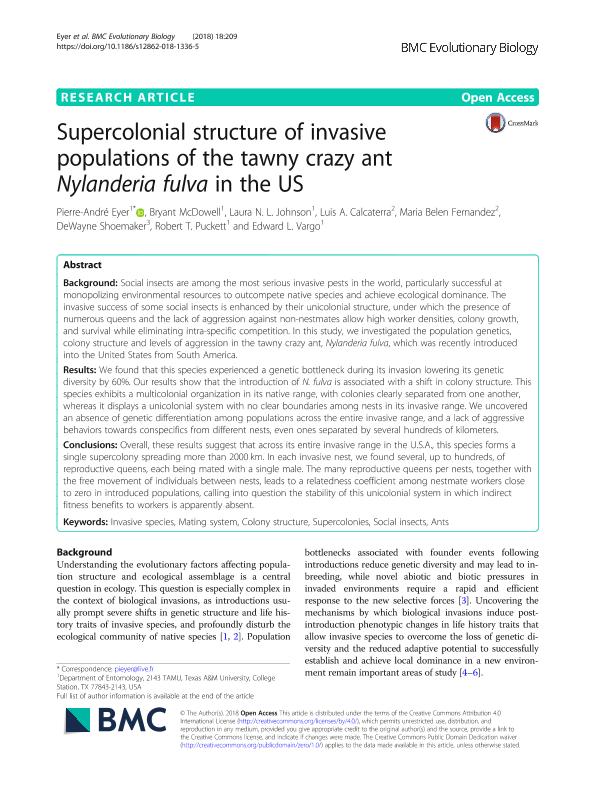Mostrar el registro sencillo del ítem
dc.contributor.author
Eyer, Pierre André
dc.contributor.author
McDowell, Bryant
dc.contributor.author
Johnson, Laura N. L.
dc.contributor.author
Calcaterra, Luis Alberto

dc.contributor.author
Fernández, María Belén

dc.contributor.author
Shoemaker, Dewayne
dc.contributor.author
Puckett, Robert T.
dc.contributor.author
Vargo, Edward L.
dc.date.available
2020-02-26T18:24:27Z
dc.date.issued
2018-12
dc.identifier.citation
Eyer, Pierre André; McDowell, Bryant; Johnson, Laura N. L.; Calcaterra, Luis Alberto; Fernández, María Belén; et al.; Supercolonial structure of invasive populations of the tawny crazy ant Nylanderia fulva in the US; BioMed Central; BMC Evolutionary Biology; 18; 1; 12-2018; 1-14
dc.identifier.issn
1471-2148
dc.identifier.uri
http://hdl.handle.net/11336/98448
dc.description.abstract
Background: Social insects are among the most serious invasive pests in the world, particularly successful at monopolizing environmental resources to outcompete native species and achieve ecological dominance. The invasive success of some social insects is enhanced by their unicolonial structure, under which the presence of numerous queens and the lack of aggression against non-nestmates allow high worker densities, colony growth, and survival while eliminating intra-specific competition. In this study, we investigated the population genetics, colony structure and levels of aggression in the tawny crazy ant, Nylanderia fulva, which was recently introduced into the United States from South America. Results: We found that this species experienced a genetic bottleneck during its invasion lowering its genetic diversity by 60%. Our results show that the introduction of N. fulva is associated with a shift in colony structure. This species exhibits a multicolonial organization in its native range, with colonies clearly separated from one another, whereas it displays a unicolonial system with no clear boundaries among nests in its invasive range. We uncovered an absence of genetic differentiation among populations across the entire invasive range, and a lack of aggressive behaviors towards conspecifics from different nests, even ones separated by several hundreds of kilometers. Conclusions: Overall, these results suggest that across its entire invasive range in the U.S.A., this species forms a single supercolony spreading more than 2000 km. In each invasive nest, we found several, up to hundreds, of reproductive queens, each being mated with a single male. The many reproductive queens per nests, together with the free movement of individuals between nests, leads to a relatedness coefficient among nestmate workers close to zero in introduced populations, calling into question the stability of this unicolonial system in which indirect fitness benefits to workers is apparently absent.
dc.format
application/pdf
dc.language.iso
eng
dc.publisher
BioMed Central

dc.rights
info:eu-repo/semantics/openAccess
dc.rights.uri
https://creativecommons.org/licenses/by-nc-sa/2.5/ar/
dc.subject
ANTS
dc.subject
COLONY STRUCTURE
dc.subject
INVASIVE SPECIES
dc.subject
MATING SYSTEM
dc.subject
SOCIAL INSECTS
dc.subject
SUPERCOLONIES
dc.subject.classification
Zoología, Ornitología, Entomología, Etología

dc.subject.classification
Ciencias Biológicas

dc.subject.classification
CIENCIAS NATURALES Y EXACTAS

dc.title
Supercolonial structure of invasive populations of the tawny crazy ant Nylanderia fulva in the US
dc.type
info:eu-repo/semantics/article
dc.type
info:ar-repo/semantics/artículo
dc.type
info:eu-repo/semantics/publishedVersion
dc.date.updated
2020-02-18T16:05:39Z
dc.journal.volume
18
dc.journal.number
1
dc.journal.pagination
1-14
dc.journal.pais
Reino Unido

dc.journal.ciudad
Londres
dc.description.fil
Fil: Eyer, Pierre André. Texas A&M University; Estados Unidos
dc.description.fil
Fil: McDowell, Bryant. Texas A&M University; Estados Unidos
dc.description.fil
Fil: Johnson, Laura N. L.. Texas A&M University; Estados Unidos
dc.description.fil
Fil: Calcaterra, Luis Alberto. Consejo Nacional de Investigaciones Científicas y Técnicas; Argentina. Fundación para el Estudio de Especies Invasivas; Argentina
dc.description.fil
Fil: Fernández, María Belén. Fundación para el Estudio de Especies Invasivas; Argentina. Consejo Nacional de Investigaciones Científicas y Técnicas; Argentina
dc.description.fil
Fil: Shoemaker, Dewayne. University of Tennessee; Estados Unidos
dc.description.fil
Fil: Puckett, Robert T.. Texas A&M University; Estados Unidos
dc.description.fil
Fil: Vargo, Edward L.. Texas A&M University; Estados Unidos
dc.journal.title
BMC Evolutionary Biology

dc.relation.alternativeid
info:eu-repo/semantics/altIdentifier/url/https://bmcevolbiol.biomedcentral.com/articles/10.1186/s12862-018-1336-5
dc.relation.alternativeid
info:eu-repo/semantics/altIdentifier/doi/http://dx.doi.org/10.1186/s12862-018-1336-5
Archivos asociados
